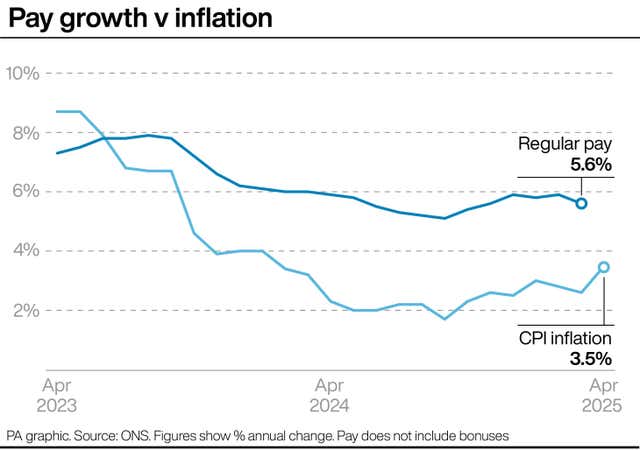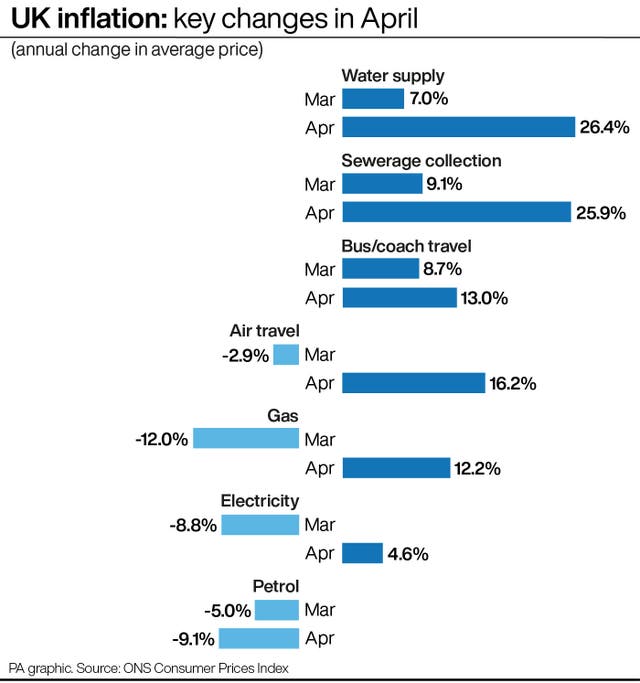Pressure mounts on Chancellor as inflation races to highest for more than a year
Official figures show Consumer Prices Index inflation jumped to 3.5% in April, up from 2.6% in March.

Inflation has rocketed to its highest level in more than a year after “awful April” bill rises, but pressure is also mounting on the Chancellor over the impact of Labour’s recent tax hike on the cost of living.
Official figures show Consumer Prices Index (CPI) inflation jumped to 3.5% in April, up from 2.6% in March and the highest since January 2024.
It comes after Ofgem’s energy price cap rose by 6.4% in April, having fallen a year earlier, alongside a raft of bill rises for under-pressure households – including the biggest increase to water bills since at least February 1988.
Households were also hit with steep increases across bills for council tax, mobile and broadband tariffs, as well as road tax.
But experts said inflation may also have been pushed higher as many firms responded to the Government’s move to raise national insurance contributions (NICs) and the minimum wage last month by increasing prices.
Chancellor Rachel Reeves acknowledged her policies have “consequences” but insisted they are necessary to stabilise the economy.
Asked if the inflation figures had been pushed up by measures including the hike in employers’ national insurance, she told broadcasters: “When I became Chancellor last year, I faced the very difficult challenge that there was a £22 billion black hole in the public finances.
“We had to fix that, and if we hadn’t done the Bank of England would not have been able to cut interest rates four times this last year, which has obviously had a direct effect on the mortgages and the rents that people pay.
“I do recognise that all policies have consequences, but if I hadn’t have acted to stabilise the public finances, we would be in a worse position today.”

Shadow chancellor Sir Mel Stride blamed Labour’s “damaging” tax increase for the rise in inflation and said “families are paying the price for the Labour Chancellor’s choices”.
The Liberal Democrats also took aim at Labour, warning the cost of living could spiral out of control unless Ms Reeves reverses her decision to increase employer NICs.
The larger-than-expected rise in inflation was the biggest since October 2022, at the height of the energy crisis, according to the Office for National Statistics (ONS).
Economists had been expecting a rise to 3.3% last month.
The figures may see the Bank of England tread more cautiously with cuts to interest rates after this month’s reduction from 4.5% to 4.25%, economists said.

Rob Wood, at Pantheon Macroeconomics, said he believes inflation will stay around 3.5% for the rest of the year.
He said: “We think the Monetary Policy Committee will have to proceed cautiously.
“We stick with two more rate cuts this year, but are very close to reducing that to only one.”
Investec economist Philip Shaw said he believes April’s painful rise will prove to be the peak and will start to come down as wage growth and energy prices ease back.
“We stand by our view that the committee will bring the Bank rate down twice more to 3.75% by the end of this year,” he said.
The unwelcome increase back above 3% comes after some recent respite, with inflation having fallen for the two previous months.
The ONS said water inflation across housing, water and energy bills surged by 7.8% in the year to April, which was the highest since June 2023.
Within this, water and sewerage charges raced 26.1% higher during April.
Air fares also contributed to the inflation jump, rising by 27.5% during the month due largely to the timing of Easter, which was the second highest monthly increase since records began.
The ONS said these increases were “partially offset by falling prices for motor fuels and clothing, driven by heavy discounting for children’s garments and women’s footwear”.
Elsewhere, the data showed the ONS’s preferred measure of inflation, Consumer Prices Index including owner occupiers’ housing (CPIH), rose to 4.1% in April from 3.4% in March.
Meanwhile, the Retail Prices Index (RPI) rate of inflation lifted to 4.5% from 3.2%.





